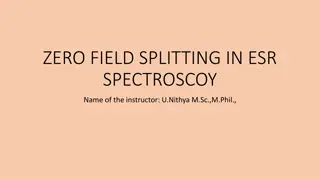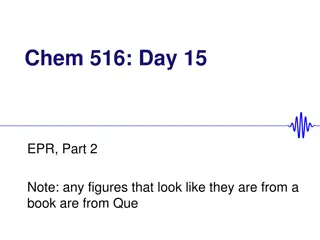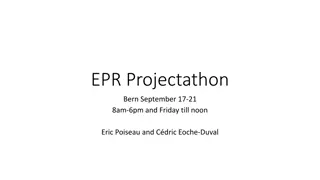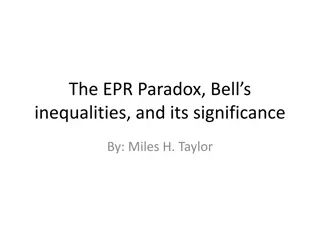
Insights into Zero-Field Splitting in Electron Paramagnetic Resonance
Explore the intriguing world of zero-field splitting in electron paramagnetic resonance, delving into topics such as spin states, energy levels, and spatial arrangements of electron spins. Discover the energetic consequences of spin orientations and the implications for magnetic properties. Uncover the intricate details of axial and rhombic distortions in the zero-field splitting Hamiltonian and their effects on the energy levels of electron spin states.
Download Presentation

Please find below an Image/Link to download the presentation.
The content on the website is provided AS IS for your information and personal use only. It may not be sold, licensed, or shared on other websites without obtaining consent from the author. If you encounter any issues during the download, it is possible that the publisher has removed the file from their server.
You are allowed to download the files provided on this website for personal or commercial use, subject to the condition that they are used lawfully. All files are the property of their respective owners.
The content on the website is provided AS IS for your information and personal use only. It may not be sold, licensed, or shared on other websites without obtaining consent from the author.
E N D
Presentation Transcript
Chem 516: Day 16 EPR, Part 3 1
Todays theme: mo spins, mo problems Zero-field splitting: another electron spin Hyperfine coupling: nuclear spin on the metal Syperhyperfine coupling: nuclear spin on the ligands 2
What we saw two classes ago for a single electron in an s orbital ms = 1/2 E E = g H ms = -1/2 H A H A H 3
Extending S=1/2 to S=5/2 ms = 5/2 E = g H ms = 3/2 E = g H ms = 1/2 E E = g H ms = -1/2 E = g H ms = -3/2 E = g H ms = -5/2 H Selection rule: ms= 1 A H A H 4
A bit simpler: just two spins (S=1) ms = 1 ms = 0 ms = -1 Remember what these ms values mean: 1 1 1 z axis z axis z axis 0 0 0 -1 -1 -1 ms = 1, ms = 0, ms = -1, 5
Lets think of these spins as little bar magnets moving in space ms = 0 ms = 1 Oh D4h Key point: the spatial arrangement of the two spins has an energetic consequence! 6
This means that even at zero field, the ms=0 energy is different from ms= 1 ms = 1 ms = 1 ms = 0 ms = 0 ms = -1 A H A H 7
You now get evenly spaced lines ms = 5/2 E ms = 3/2 ms = 1/2 4D 2D ms = -1/2 ms = -3/2 D= zero field splitting Measures anisotropy ms = -5/2 H Selection rule: ms= 1 A H A H 8
There is a zero-field splitting Hamiltonian: 2 1 3?2+? 2 ?? 2 ????= ? ?? ?? ? D is the axial ZFS, E/D is the rhombic distortion. For pure axial symmetry, the energy of each ms state is: 2 1 ??????(??) = ? ?? 3?(? 1) So for the S=5/2 case, we have: 2 ?????? ??= 5 5 2 1 5 2 5 2 1 = 5D = ? 2 3 2 ?????? ??= 3 3 2 1 3 2 3 2 1 = 1D = ? 2 3 2 ?????? ??= 1 1 2 1 1 2(1 2 1) = -1D = ? 2 3 This gives us the 4D and 2D spacing on the previous slide 9 Note: I added this slide after class
That was the easiest case! Rhombic symmetry adds E term for the additional loss of symmetry If you are lucky, D is small compared to h (say 0.1 cm-1 vs ~1.0) , but in some systems like Fe(III) porphyrins, it s much larger: 10
Moving on to nuclear spins: start with hydrogen atom again (nuc spin I=1/2) HLab For hydrogen, Hhyperfine=50*mI mT In X-band, for g=2, HLab = 330 mT 11
Depending on mI, the nuclear magnetic moment helps or hinders HLab mI= 1/2 ? ms = 1/2 E mI= -1/2 ? ? mI= -1/2 ms = -1/2 ? mI= 1/2 HLab (mT) 305 330 355 A HLab E = g HLab+ Amsmi Hyperfine coupling constant, 0.025 cm-1 12 Note selection rule: mI = 0, ms = 1
Different nuclei have different nuc. spin Nucleus Spin 1 1 7/2 3/2 1H 2D 14N 31P 59Co 63,65Cu The number of hyperfine peaks is 2I+1, so a Cu atom will give 4 peaks 13
An example of a Cu system (Que p. 165) g = 2.35 Before hyperfine: g = 2.05 After hyperfine: Az=0.015 cm-1 14
But why is this only on gz? Hyperfine interaction is anisotropic, and depends on the orbital the spin is in: Please read Que Chap 3, section IIIA,B for details 15
Superhyperfine splitting: nuclear spins on ligands ?2 ?2 N N ?2 Cu N N ?? ??,?? - Each N has I=1, and there are 4 of them. Total number of lines is 2nI+1 = 9 - Superhyperfine splitting is smaller than HF: ~0.001 cm-1 - Ligands are along xy plane, so only observed in g - Remember the peak height patters in NMR? Same story here. For two Ns, you d get 5 peaks with height ratios of 1:2:3:2:1 16
An example of a Cu system (Que p. 165) After hyperfine: Az=0.015 cm-1 After superhyperfine: 17
Bringing it all together In groups: Summarize the causes of ZF, HF, and SFH splitting. How do they manifest in the spectrum, and what is similar and different about that manifestation? Discuss in groups for 5 minutes, write down an answer. 18

















